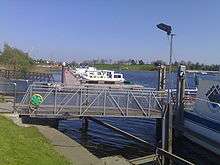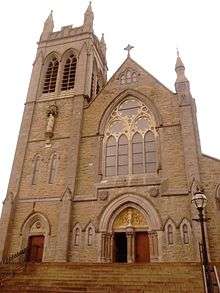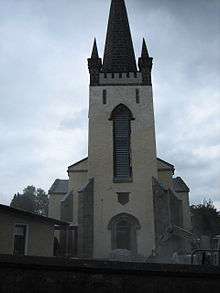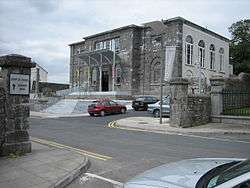Carrick-on-Shannon
| Carrick-on-Shannon Cora Droma Rúisc | |
|---|---|
| Town | |
|
The Dock, former courthouse which is now an arts centre. | |
 Carrick-on-Shannon Location in Ireland | |
| Coordinates: 53°56′38″N 8°05′42″W / 53.944°N 8.095°WCoordinates: 53°56′38″N 8°05′42″W / 53.944°N 8.095°W | |
| Country | Ireland |
| Province | Connacht |
| County | County Leitrim & County Roscommon |
| Elevation | 45 m (148 ft) |
| Population (2016)[1] | |
| • Total | 5,931 |
| Irish Grid Reference | M935996 |
| Website |
www |
Carrick-on-Shannon (Irish: Cora Droma Rúisc, meaning "the Rock of the marshy ridge") is the county town of County Leitrim in the Republic of Ireland. It is the largest town in the county of Leitrim and the smallest main county town in the entire country. The population of the town was 5,931 in 2016.[1] It is situated on a strategic crossing point of the River Shannon. The town is in the civil parish of Kiltogert which is in the ancient barony of Leitrim.[2] For ecclesiastical purposes, the town is in the parish of Kiltoghert in the Roman Catholic Diocese of Ardagh and Clonmacnoise[3] The nearest Anglican church is in Drumshanbo in the Diocese of Kilmore, Elphin and Ardagh.[4]
History
Carrick-on-Shannon is situated on a fording point of the Shannon. In the vicinity of Drumsna, on the County Roscommon border, are the remains of an Iron Age fortification,. As an ancient stronghold of the O'Rourkes of Breifne and their ofttimes rivals, the O'Raghnaills (Reynolds) of North Roscommon, the town was granted a royal charter and named a borough with its own seal in 1607.[5]
Historic buildings are the "Carrick Castle", the Workhouse and Famine Graveyard, Hatley Manor (a restored Georgian period home of the St. George Family), St George's Church of Ireland and the Costello Chapel.
It is the gateway to the Shannon–Erne Waterway, Lough Key, Acres Lake and Lough Allen via the picturesque villages of Cootehall, Knockvicar, Jamestown, Leitrim Village, Drumshanbo and Keshcarrigan and is only a short distance away from the Glens of North Leitrim.
Local media
Carrick-on-Shannon is served by the Leitrim Observer which is published every Wednesday and the fortnightly free Northwest Express newspapers. The Leitrim Post is now defunct.[6][7][8]
Places of interest
Carrick Bridge and Quay

Until the early 19th Century, the head of the Shannon Navigation was Drumsna. In the 1840s the improvement of the navigation entailed extensive dredging of the river, the cutting of Jamestown Canal, the construction of locks at Drumsna and Knockvicar, and the building of a new bridge and Quays at Carrick-on-Shannon. The new bridge, built in 1846, took the place of a nine arch stone bridge, which in turn replaced a wooden structure.
For over a century, until the closing of the Grand Canal Company in 1960, Carrick was a major depot for river trade; timber, cement, hardware, and especially Guinness stout were all transported here from Dublin, Athlone and Limerick.
Nearby is the clubhouse of Carrick-on-Shannon Rowing Club, which has been one of the foremost in the country since its establishment in 1827.
The annual regatta at the August Holiday was a famed highlight of the festive season in the whole North West. M.J. McManus recalls that he watched...
"In August sunshine, the eights and the fours and the pleasure boats and the turf-cots competing on Carrick's day of days."
Churches

St. Mary's Catholic Church, on the Main Street, is built in the Neo-Gothic style. It was designed by W.H. Hague, a Dublin architect. It was dedicated on 19 October 1879. The church is on a plot of elevated ground. Fr. Thomas Fitzgerald, the priest responsible for its construction, is buried within the chancel in front of the Blessed Sacrament Altar.

St. George's Church, St. Mary's Close, is the Church of Ireland parish Church. Prior to 1698, the parish church was situated at Kiltoghert. In that year it was transferred to its present site in Carrick. It was re-built in 1829 and the interior reconstructed in the years 1910-1914. Rev. W.A. Percy who was Rector from 1869 to 1886 was grandfather of the famous song writer Percy French.
"The Priest's Lane" was the old name for the road at the Swan Bar leading to St. Patrick's Park. This was where the Catholic clergy first lived after the relaxation of the Penal Laws. It is also reputed to have been the home of Turlough O'Carolan, the harpist and composer when he came to Carrick as a boy with his family from Nobber, Co. Meath in 1684.[9]
The Carrick Baptist Church was started in September 2012. The church holds its services on Park Lane.
Arts
The Very Small Gallery is located in 'The Bush Craft Yard'.
The Dock is an arts centre housed in the renovated 19th Century courthouse building. It was opened in 2005. The arts centre has a theatre, art galleries, artists' studios, workshop spaces, a coffee shop and theatre bar and The Leitrim Design House. It also holds the "Phase One" festival which is held at the beginning of April every year, a phase dedicated to displaying artists and musicians associated with modern or electronic music, the festival having started in 2013.
Climate
Carrick on Shannon experiences a year-round mild, moist, temperate and changeable climate, due to the prevailing winds of the Gulf Stream. The town experiences a lack of temperature extremes, with temperatures below 0 °C (32 °F) and above 30 °C (86 °F) being rare. The town receives an average of 1,147 mm (45.2") of precipitation annually, which is evenly distributed throughout the year. Rain is the most common form of precipitation - hail, sleet and snow are rare in the town, though will sometimes be experienced during particularly cold winters. Carrick-on-Shannon is also consistently humid, with humidity normally ranging from 70% to 100%, and this can lead to heavy showers, and even thunderstorms breaking out when drier east winds, originating in the European continent, clash with this humidity particularly in the late summer.
The average January temperature in the town is 6.8 °C (40.6 °F) and the average July temperature is 16.0 °C (60.8 °F). This means that Carrick-on-Shannon is said to have a maritime temperate climate (Cfb) according to the Köppen climate classification system.
While extreme weather is rare, the town and county can experience severe windstorms that are the result of vigorous Atlantic depressions that occasionally pass along the north west coast of Ireland. Most of these storms occur between late autumn and early spring.
Due to the town's north westerly location, it has long summer days. Daylight at midsummer is before 04:00 and lasts until after 23:00. In midwinter, daylight does not start until 09.00, and has gone by 16:00.
Geography
As its name implies, the town is located on the River Shannon, which is linked to the River Erne via the Shannon–Erne Waterway. The town is located on the N4 National Primary Route, linking Dublin in the east to Sligo in the west. The road is of motorway status for much of its length.
The town is served by the Dublin-Sligo railway line. Carrick-on-Shannon railway station opened on 3 December 1862.[10] This line was originally part of the Midland Great Western Railway. The railway station is approximately 2 kilometres outside town on the Roscommon side of the Shannon. Bus Éireann bus services connect the town to Dublin and Sligo. There is a regularLocallink Bus Service to Ballinamore viia Mohill. Carrick-on-Shannon, while the county town of Leitrim, straddles the river Shannon. That part of the town on the Roscommon side is the townland of Cortober.
The Leitrim part of the town is situated in the townland of Townparks which is part of the extensive civil parish of Kiltoghert.[11]
Sport
- Gaelic games - St Mary's GAA Club, based in the parish of Kiltoghert.[12] The club was re-formed in March 1944. For 55 years, the club rented the Show Grounds on the Boyle Road.
- Golf - Carrick on Shannon Golf Club [13] The townland of Ballinamoney was first the first site for a golf course. In 1936 the club moved to a site nearer the town in Lisnagot. In 1944 it moved to its present location in Woodbrook.
- Rowing - Carrick on Shannon Rowing Club[14] The club was founded in 1836 and as such, it is the oldest rowing club in the Republic of Ireland as well as one of the oldest in the world.
- Rugby Carrick on Shannon R.F.C. Est. 1974
- Soccer - Carrick Town FC was founded in 1976. The home ground is located at the Showgrounds on the Boyle Road.
- Fishing. The locality has hosted National and International Fishing Competitions.
Notable residents
- Carole Coleman, Raidió Teilifís Éireann broadcaster.
- William Lendrim, Victoria Cross recipient.
- Ronan McGreevy, journalist with The Irish Times.
- Farrell McElgunn, former local politician and member of the Seanad and the European Parliament[15]
Twinning
Carrick-on-Shannon is twinned with the following places:
 Cesson-Sévigné, Brittany, France
Cesson-Sévigné, Brittany, France
See also
References
- 1 2 "Population Classified by Area" (PDF). Central Statistics Office (Ireland). April 2012. p. 47. Retrieved 25 October 2016.
- ↑ Placenames Database of Ireland - town of Carrick-on-Shannon
- ↑ Roman Catholic Diocese of Ardagh and Clonmacnoise - map of parishes.
- ↑ "Mohill:Diocese of Ardagh". Church of Ireland, official. Retrieved 5 January 2014.
- ↑ Carrick Heritage
- ↑ Leitrim Observer
- ↑ Northwest Express - Distribution and Circulation
- ↑ RTÉ News - Leitrim Post to Close
- ↑ Carrick Heritage - Historical Society
- ↑ "Carrick on Shannon station" (PDF). Railscot - Irish Railways. Retrieved 2007-09-05.
- ↑ Placenames Database of Ireland - civil parish of Kiltoghert
- ↑ Gaelic games club website
- ↑ Golf club website
- ↑ Rowing club website
- ↑ Elections Ireland http://electionsireland.org/candidate.cfm?ID=2960&sort=party&office=yes. Retrieved 1 December 2016. Missing or empty
|title=(help)
External links
| Wikimedia Commons has media related to Carrick-on-Shannon. |
| Wikisource has the text of the 1911 Encyclopædia Britannica article Carrick-on-Shannon. |
| Wikivoyage has a travel guide for Carrick-on-Shannon. |
- Tour of Old Carrick-on-Shannon
- Carrick on Shannon Chamber of Commerce
- The Dock Arts Centre
- Carrick-on-Shannon RFC

